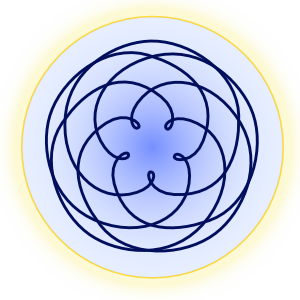The Invisible Part of Man
Conventional science still maintains that humans have only the visible body or organism; that all life activities are confined just to what lies within the perimeter of the physical; that consciousness can be reduced to a collection of chemical and electromagnetic processes occurring within the brain and the organism in general. This has tremendous implications, because if all is limited to the physical body, then the inevitable deterioration of this body will indicate the end of life, of man’s being and consciousness, the annihilation of the identity of the self. No wonder that modern times’ frenzy is characterized by a desperate search for ways to prolong the life of the physical body, by a constant rush to enjoy all that can be possibly enjoyed, because, as they say, “you only live once”. But serious seekers should look deeper.
Published on May 27, 2021
There is much around us, which is invisible to the “ordinary” eye and not recorded by the normal five senses of an average human being. There is a magnitude of phenomena, which an ordinary man cannot sense and therefore are considered as non-existent to the majority of the present inhabitants of our planet Terra or Earth. And of course, there are causes for such phenomena, which are a total mystery for the majority as they are barely only able to record the effects of such causes. Examples of the latter is the activity of the forces of nature or the causes of most diseases, but that is a subject of another analysis.
Expressed differently – everything is above all what it appears to be: physical material reality, but beside that always something totally different and immensely more.
The above mentioned is true also of the constitution of a human being. There is much, which is invisible for the majority, including the causes of being able to function at all as a human being, to sense, feel, think and act in the visible physical world.

Our ancestors did possess a knowledge of man’s far wider and deeper constitution than is acknowledged nowadays. There was hardly any primitive tribe or civilized nation before the advent of modern times that did not possess the traditional teaching of a multiplicity of human subtle bodies or envelopes, one of which expressly is closely connected with the organism. The umbra or “shadow” of the Romans, the ka of the Egyptians, the linga sharīra or prānamaya kosha of the Hindus, and the po of the Chinese, are familiar to historians of culture and religion. In addition we have the iklozi or ithongi of the Zulus, the udjibbom of the Ojibwa Indians, the anigi of the Central American Black Caribs, to cite only a few further examples corresponding to the umbra, etc. of the Romans. How can there be such a consensus between widely separate peoples if their ideas did not refer to real things?1
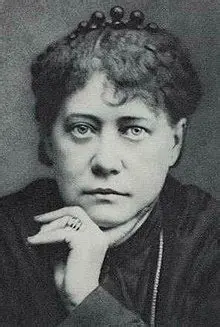
Surely, there are and have been those to whom the “invisible phenomena” around us and inside us are not invisible or at least to a significant part. One of the most notable in our recent past has been Helena Petrovna Blavatsky (1831-1891), who amongst other phenomena was accurately and objectively able to describe people’s emotions, thought patterns, medical conditions and subsequent cures for those conditions. She also made innumerable authentic demonstrations how mental energy dominates physical matter and showed that there certainly is much more in man and in the surrounding than ordinary human eye and senses are able to perceive. She has described the invisible part of our world e.g. in her voluminous books Isis Unveiled (1877) and The Secret Doctrine (1888).
Charles Webster Leadbeater (1847-1934) was a prolific researcher, author and writer into superphysical realities. He was able to see the “invisible” envelopes of men and described his observations of different human envelopes and phenomena in them in his books Man Visible and Invisible (1902) and Chakras (1927).
Annie Besant (1847-1933) was a researcher, author, educator and social activist. She has desbribed her extrasensory observations in her books Man and His Bodies (1896) and Thought Forms (co-author C.W. Leadbeater, 1901).
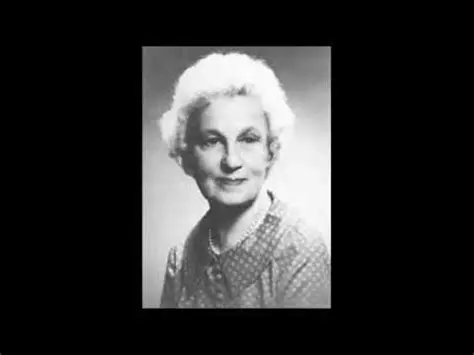
Dora van Gelder Kunz (1904-1999) was a so-called natural talent of extrasensory abilities who was from an early childhood encouraged by her parents and trained by C. W. Leadbeater. She was able to see the “invisible” envelopes of man and was particularly known for her work with the unseen human field energies in an individual. Since childhood Mrs Kunz was aware of such forces, and she made a lifetime study of how they work and how they relate to attitudes and emotions, this awareness later evolved into an understanding of the universal healing field from which both healers and patients can draw fresh, potent healing energies.2 She has described her experiences in several books, e.g. The Personal Aura (1991) and The Chakras and the Human Energy Fields (co-author Shafica Karagulla, 1989), where she conducts medical research with Dr Karagulla by using her perception of auras to describe patients conditions.
Phoebe Payne Bendit (1891-1978) had extrasensory abilities from her early years, but she was not aware until she reached adult life that other people could not see the things she saw. She saw a field of force around human beings that changed in color and intensity with their emotions and attitudes or their state of health. She learned to judge the quality of people’s character by the color and condition of this energy field which she saw around them. E.g. she was frequently puzzled that other people did not know when some individual was lying, as it was so obvious to her. Later in her life she worked with her psychiatrist husband, Laurence J. Bendit, in helping people with their problems. She has written a book on her experiences, Man’s Latent Powers (1938).3
So, in our times, interest in finding out more about man and our existence has slowly, but gradually increased. While the physicalist theory of the world is still rigidly holding ground, there are those who have presented a much larger view through their research.
Modern research into and evidence of the “invisible” part of man
Research by Dr Shafica Karagulla

Dr Shafica Karagulla (1914-1986) was a medical doctor, neuro-psychiatrist and scientist, who in her research delved deep into the hidden side of human abilities and constitution. She was educated in the Medical School of American University of Beirut (degree of Doctor of Medicine and Surgery, 1940), then specialized in psychiatry in Scotland, where she took her residency at the Royal Edinburgh Hospital for Mental and Nervous Disorders. In 1948 she obtained a diploma in psychological medicine (D.P.M.) from the Royal College of Physicians of London and the Royal College of Surgeons of England and in 1950 she became a Member of the Royal College of Physicians of Edinburgh (M.R.C.P.Ed.), the highest medical qualification in Great Britain.
During many years Dr Karagulla researched thoroughly people, who appeared to have so-called extrasensory abilities, which far exceed the abilities and five senses of an ordinary human being. She used scientific methods and recorded her findings and observations of many types of extrasensory abilities in her book Breakthrough to Creativity (1967).
Regarding human constitution, she made a number of important observations during her research e.g. on and with Dora van Gelder Kunz, who Dr Karagulla regarded one of the most gifted individuals she had ever encountered. Mrs Kunz had control of her gifts (abilities) and could use them efficiently at any time. Mrs Kunz was able to see the physical organs inside the body and any pathology or disturbance in function. Though she had not studied medicine and often used layman’s terminology, her descriptions were accurate and clear and easily translated into medical terms. Medical diagnosis proved that Dora Kunz was correct and accurate in what she saw in all the many cases she worked with. Above that Mrs Kunz was also able to see a “vital or energy body” (editor: etheric envelope) which sub-stands the dense physical body, interpenetrating it like a sparkling web of light beams. This web of light frequencies is in constant movement and apparently looks somewhat like the lines of light on a television screen when a picture is not in focus. This energy body extends in and through the dense physical body and for an inch or two (2-6 cm) beyond the body and is a replica of the physical body. Mrs Kunz insisted that any disturbance in the physical structure itself is preceded and later accompanied by disturbances in this energy body. Within this energy body, or pattern of frequencies she observes eight major vortices of force and many smaller vortices.
Not only was Dora Kunz aware of the conditions of the physical body and its energy counterpart (energy body), but she also saw a so-called emotional or sentinent field (editor: emotional envelope). This field extends a foot to eighteen inches (30-45 cm) from the periphery of the body and is ovoid in form. In this field Mrs Kunz evidenced colors and energy patterns which indicate emotional states and conditions. She also was able determine e.g. whether a person is honest and trustworthy.4 Mrs Kunz has herself written that there is also a real physical basis for such abilities (clairvoyance). The power centers in a tiny organ in the brain called the pituitary gland. The kind of vibrations involved are very subtle and there is a special spot of sensitiveness between the eyes above the root of the nose which acts as the external opening for the gland within.5
After meticulous research and experiments, Dr Karagulla asserted as one of the conclusions of her research that man has a vital field of physical energy which is at the edge of visibility. It expresses as a web of light extending several inches (2-6 cm) beyond the body. Moreover, man also has an emotional field extending to about eighteen inches (45 cm) beyond the body and a mental or intellectual field extending two feet (60 cm) or more. Additionally, in her book The Chakras and the Human Energy Fields (1989), co-authored with Dora van Gelder Kunz, Dr Karagulla describes the etheric, astral (emotional), mental and causal bodies of man. She not only recognized and investigated the presence of these fields, but also attributed to them the quality of bodies, integral parts of the human being.
Research by Charles Webster Leadbeater
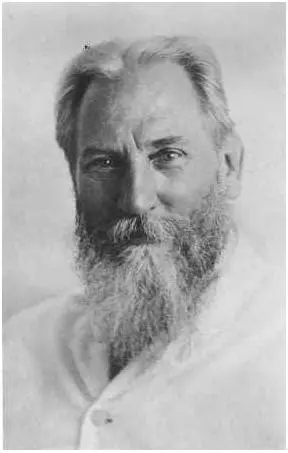
C. W. Leadbeater (1847-1934) was able to see different superphysical realities and described his experiences and experiments in methodic detail in his several books and lectures. He described his means for research as clairvoyant methods, though he was strongly aware of how sorely misused and even degraded this term is. Nevertheless, he defined clairvoyance as the power to see what is hidden from ordinary physical sight and stated that it is frequently accompanied by what is called clairaudience, or the power to hear what would be inaudible to the ordinary physical.6
To him and to those who are in the habit of seriously studying clairvoyance, this was a matter of direct knowledge and certainty, although it is presented to the consideration of the world merely as a hypothesis. He stated that it is exceedingly difficult for the average man to realize that in proportion to the whole that is to be seen, his power of vision is very much more imperfect than those who possess extrasensory abilities. Also, an average man is strongly disposed to hint that those who see a little more than he does must really be drawing upon their imagination for their alleged facts. It is one of the commonest of mistakes to consider that the limit of our power of perception is also the limit of all that there is to perceive.

Yet the scientific evidence is indisputable, and the infinitesimal proportion (as compared to the whole) of the groups of vibrations by which alone we can see or hear is a fact about which there can be no doubt. The clairvoyant is simply a man who develops within himself the power to respond to another octave out of the stupendous gamut of possible vibrations, and so enables himself to see more of the world around him than those of more limited perception.7
Leadbeater discerned between different kinds of clairvoyance – an ability to see the etheric matter and etheric body (etheric vision or clairvoyance), which consists in susceptibility to a far larger series of physical vibrations than ordinary and its possession brings into view a good deal to which the majority of the human race still remains blind. Then the ability to see the astral or emotional body (emotional clairvoyance), the mental body (mental clairvoyance) and causal body (causal clairvoyance). Especially the latter, but also the mental one are very rare abilities and are present only in a highly developed human being. Emotional clairvoyance is the most common and can occur on lower developmental levels, than e.g. etheric vision.8
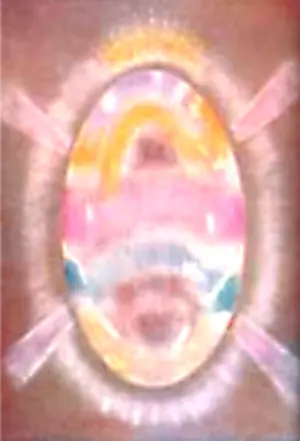
Of course, different types of clairvoyance can be expressed in different quality and depth, they can be fully developed or only partially so, they can be intentional and unintentional. But to the trained clairvoyant who is able to employ all these various degrees of sight in turn, the entire life of the man in all its stages lies open like a book; for on these higher planes no man can hide or disguise himself; what he truly is, is seen to be by any unprejudiced spectator.9
According to Leadbeater’s sight and experience, the soul of man has not one body, but many bodies, for when sufficiently evolved he is able to express himself on ail these different levels of nature, and he is therefore provided with a suitable vehicle of the matter belonging to each, and it is through these various vehicles that he is able to receive impressions from the world to which they correspond. Man has not only the physical body which we see, but he has also within him what we may describe as bodies appropriate to different worlds of nature, and consisting in each case of their matter. In man’s physical body there is etheric matter as well as the solid matter which is visible to us. He has a body of astral (emotional) matter and exactly the same thing is true with regard to the mental matter in its turn, as man also has a mental body. Man’s highest body is the causal body.10
Research of out-of-body experiences
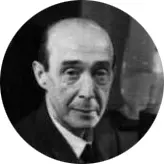
There have been a number of researches who have experimented and documented their research on the so-called out-of-body journeys, also called astral projection. Oliver Fox (1885-1949) can be regarded as one of the pioneers of out-of-body experiences in the West with his articles in the “Occult Review” published in 1920, which caused Hereward Carrington to comment on those pieces as follows: “The only detailed, scientific and first-hand account of a series of conscious and voluntarily controlled astral projections which I have ever come across.” Oliver Fox’ expanded his series of articles into a book called “Astral Projection: A Record of Out-of-the-Body Experiences”, which was published in 1939 (in the US in 1962), where he describes in practical terms his many out-of-body experiences and reveals several hints about the technique, which he is using to effect such conscious aparting from the physical organism. In his own words, the book contains a large amount of evidence – verifiable, if the reader is prepared to take the trouble – that it is possible to obtain a new state of consciousness in which the soul appears to function outside of the physical body.11
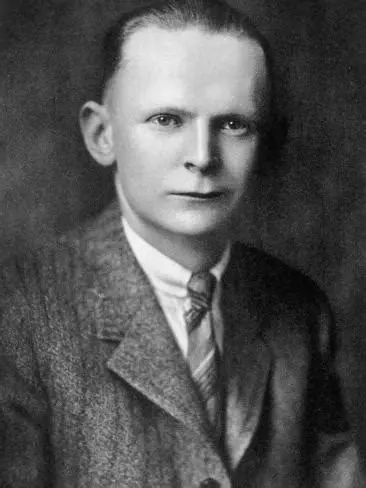
Sylvan J. Muldoon (1903-1969) and Hereward Carrington (1880-1958) conducted their research on such phenomena during a number of years and jointly published their records in The Projection of the Astral Body (1929) and The Phenemena of Astral Projection (1951). In the latter book they discuss about the existence of a subtle body. They point out that mankind has a massive weight of human belief and testimony into the subtler human bodies, from the earliest times to our own day, in all parts of the world, and among civilized and uncivilized peoples. Then we have those cases of apparitions in which the so-called phantom-form seems to exhibit a mind of its own – often imparting information unknown to the seer at the time, but afterwards verified. Also, we have those cases in which material effects are apparently produced by the phantom, or its image appears upon photographic plates. In the cases of astral projection the subject sees his own phantom body and is occasionally seen by others.
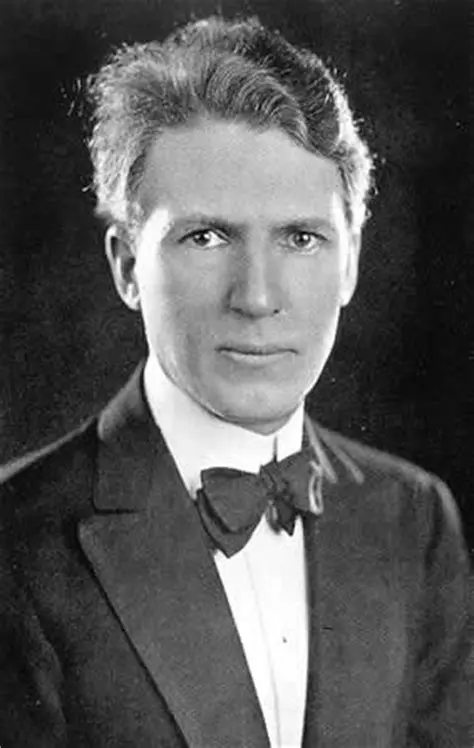
In these last instances especially, we have evidence that the phantom-form possesses a mind of its own, separate and distinct from the physical brain and body, which latter may be seen resting upon the bed. In their opinion, the cumulative mass of such testimony is most impressive and gives the right to believe that such a ‘spiritual body’ exists – as St. Paul long ago stated.12
Lately, Robert Bruce, has contributed to the research of out-of-body experiences, especially sharing his comprehension on the techniques and methods to produce a stable and skillful out-of-body experience. He has published several books, most well-known of them probably Astral Dynamics: The Complete Book of Out-of-Body Experiences (2009).
Some cases of human existence without the physical organism or the five senses
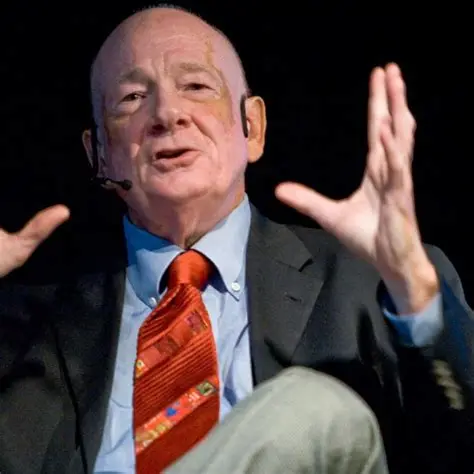
There are thousands of recorded cases of near-death, after-death and out-of-body experiences, which indicate that man consists of much more than just the physical organism visible to the ordinary eye and that man is able to successfully exist, record memories and be consciously alive without the organism and the interference of the five senses. Dr Mary Neal has claimed that there are almost 20 million people in the US alone, who have had profoundly transformative near-death experiences.13 Research has stated that near-death experiences (NDE’s) are reported by about 17% of those who nearly die.14 Dr Raymond Moody has in his research tried to highlight some characteristic features that are commonly observed in NDE’s, a la a perception of seeing and hearing apart from the physical body, passing into or through a tunnel, encountering a mystical light, intense and generally positive emotions, a review of part or all of their prior life experiences, encountering deceased loved ones, and a choice to return to their earthly life.15 Dr Jeffrey Long, a founder of the Near Death Experience Research Foundation’s comprehesive website (nderf.org) and database of NDE cases, has pointed out that considering NDE’s from both a medical perspective and logically, it should not be possible for unconscious, comatose or clinically dead people to often report highly lucid experiences that are clear and logically structured. Most NDE’rs report supernormal consciousness at the time of their NDE’s.16
In the following, we have highlighted just some of such experiences in order to describe the context of such phenomena, for which the physicalist science community is unable to give any rational explanation to. These experiences point to the fact the human being can be conscious in his subtler body or bodies even when the physical organism is paralyzed, comatose or considered dead.
The case of Dr Mary Neal
An orthopaedic spine surgeon and the former Director of Spine Surgery at the University of South California, Dr Mary Neal, was drowned while kayaking on a river in Chile in 1999.17 She became trapped under a waterfall for at least 12-15 minutes, completely under water. The people who resuscitated her (kayaking professionals) would say that she was without oxygen for up to 30 minutes. Tom Long, a friend and EMT (emergency medical technician) who was with Neal when she drowned, has described that after 90 seconds under water, Neal couldn’t have been breathing anymore. I don’t know what happened, Long said. We’re 24 minutes into it; she’s dead. Blue, waxy, no heartbeat, no breathing, cold-to-the-touch dead.18 Human brain cannot survive without oxygen for more than 5-6 minutes at most. At the one-minute mark, brain cells begin dying and at 10 minutes, even if the brain remains alive, a coma and lasting brain damage are almost inevitable.19
In her own words, from a speech given at an IANDS (International Association for Near Death Studies) conference:
My thinking along was “OK, I know that I have been underwater for too long to still be alive… I knew that I wasn’t hallucinating. I kept doing self-assessment exams… I can still feel the water, I can still feel the current working on my body, I can still feel my body being sucked out of the boat … I can feel my knees bending backwards … the ligaments tearing … and I still felt absolutely wonderful, had no pain, and so my body came over the front deck of the boat … I can feel my spirit peeling away from my my body, sort like peeling apart two pieces of a tape, eventually my body broke free from the boat, then my spirit rose up and out of the river …”20
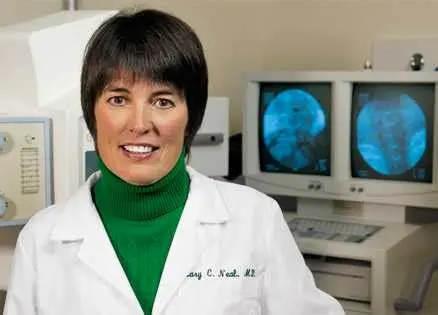
According to Dr Neal, after rising up from her body and at the same time seeing her lifeless body and all around it in an ongoing fashion, she had a vivid experience of the afterlife and incredible joy and love, which was poured in her by God. She experienced a life review, which made her truly understand that every action, every decision, every choice, every human interaction really does matter. She was greeted by a group of radiant beings, who were exuding incredible love ad she was taken down a incredibly beautiful path to a dome-like structure, which was exploding with color and absolute pure love. She interpreted it as the entrance to heaven. At one point she was told that it wasn’t yet her time, and she was sent back to her body and was told that she had more work to do. After returning, her broken body was finally taken to the hospital through a tiresome journey through the Chile wildlife. Dr Neal suffered two broken legs, multiple fractures, torn ligaments and lung problems as a result of the incident and spent a month in the hospital. But she had no pain for almost a week and a half after the incident, though she was not given painkillers. At the hospital she had another out-of-body experience, where she felt being back in God’s world.
She has described herself as a sceptic, even cynic and spent a number of months trying to think about her experiences. She tried to come up with an alternative explanation and certainly questioned her experiences. The easy explanations — dreams or hallucinations – she could discount quickly, because the experience – and the experience described by anyone who’s had a near death experience – is entirely different in quality and memory from a dream or hallucination. Also, the memory is as precise and accurate years later, as it is when it’s happening.21
The case of Dr Eben Alexander
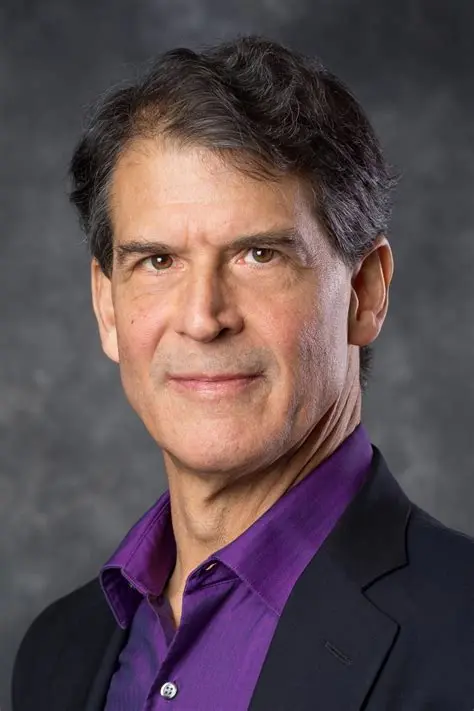
On Nov 10, 2008, neurosurgeon Dr Eben Alexander III became suddenly very ill with acute bacterial meningoencephalitis and within four hours, he was deep in coma. He was assessed to have moderate brain injury, which rapidly progressed to severe brain injury over the next few hours. He spent the next seven days comatose, on a ventilator. On the seventh day he surprisingly woke up from his coma and within a few months had made what his surprised neurologists called a ‘complete and remarkable recovery’ from an illness they agreed might well have been fatal, without any residual neurological deficit.22 His meningoencephalitis had been so severe that his original memories from within coma did not include any recollections from his life before coma, including language and any knowledge of humans or this universe. However, he was able to remember in detail his elaborate and rich odyssey of a near-death experience in superphysical reality, which he experienced while being in coma. He wrote it down during the next six weeks, comprising more than 20,000 words and eventually publishing his experiences in a book Proof of Heaven (2012).
His coma taught him that near-death experiences reveal crucial truths about the nature of existence. Simply dismissing them as hallucinations is convenient for many in the conventional scientific community, but only continues to lead them away from the deeper truth these experiences are revealing to us. The conventional reductive physicalist model embraced by many in the scientific community, including its assumption that the physical brain creates consciousness and that our human existence is birth-to-death and nothing more, is fundamentally flawed. At its core, that physicalist model intentionally ignores what he believes is the fundament of all existence — consciousness itself.23
The case of Yulia Vorobiova, the X-Ray woman24

Yulia Fyodorovna Vorobiova, known also as the Miracle of Donetsk, and the X-Ray woman, was a mine crane operator in Russia. On the 3rd of March of 1978, she was hit with a 380 volts electric discharge. Her blackened and burnt body was carried to the morgue. On the official papers the doctors wrote “cause of death: electric current”. Three days later, when the medical practitioner poked her with a scalpel, she woke up. The resurrected woman was given disability status, and her family was warned that she would not live for long. Half a year later she was diagnosed in a clinic in Odessa as completely blind. However, Yulia was able to see what people had had for breakfast and lunch. Then she saw a calf within a pregnant cow.
Shortly after, she started studies in a medical technical college to learn anatomy and understand better what she was able to see. First she learned to differentiate the organs, then to tell apart the healthy from the sick ones, then to diagnose unhealthy situations not yet manifested. News about her fast spread over Donetsk region, then over the whole Soviet Union. At the beginning sick people that doctors had a hard time diagnosing would come to her, then doctors would bring to her cases that they were finding difficult. After a while other scientists became interested in her. After a series of tests, the famous ophthalmologist Sviatoslav Fyodorov concluded that she was completely blind. In a test in the Kiev Institute for Nuclear Research, she was put in a dark room with 2000 targets. Each time a laser invisible to the human eye was directed to one of the targets. She indicated which without one single mistake.25 The probability of this occurring by chance is 1 out of 2000, i.e., 0,0005. If the experiment is conducted, say, 10 times, then the probability of indicating the correct target without mistakes is 0,0005 raised to the tenth power, or 33 zeros after the decimal comma followed by 9765625. For illustration, this is the probability: 0,0000000000000000000000000000000009765625.
The case of Robert A. Monroe (1915-1995)
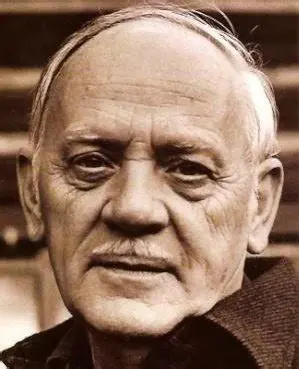
Robert A. Monroe was a successful and distinguished business executive, dedicated family man, and noted pioneer in the investigation of human consciousness. He started out as a producer and director of weekly radio programs and eventually formed his own radio production company. In 1956 his firm set up a research and development division to study the effects of various sound patterns on human consciousness, including the feasibility of learning during sleep. Monroe often used himself as a test subject for this research.
In 1958, Monroe began spontaneously experiencing a state of consciousness separate and apart from the physical body, of which he was terrified in the beginning, but started to research and control later. He described the state as an “out-of-body experience”, the term popularized by Charles T. Tart, Ph.D. a leader in the area of consciousness studies. These out-of-body floating experiences altered the course of Monroe’s life and the direction of his professional efforts. While continuing his successful broadcasting activities, Monroe began to experiment with and research the expanded forms of consciousness that he was experiencing.
In the early 1970s he founded the Monroe Institute for carrying out such research. He chronicled his early explorations with a reporter’s objectivity and eye for detail in a book, Journeys Out of the Body, which was published in 1971. This public record of his out-of-body experiences in states beyond space, time, and death attracted the attention of academic researchers, medical practitioners, engineers, and other professionals. His second book was published in 1985, titled Far Journeys, which expanded upon his personal investigations of non-physical reality and in 1994 he followed suit with a third book, Ultimate Journey, which tries to explore the meaning and purpose of life and what lies beyond the limits of our physical world.26
Obviously, serious seekers are clearly looking for a world view, which amongst others gives a rational explanation to all such experiences described and comprises them into a comprehensive whole. Fortunately we have been presented with such a system of thought.
Hylozoic explanation of the constitution of man
Philosopher Pythagoras, the leader of an esoteric knowledge order, compiled ancient wisdom into a groundbreaking world-view, which he called hylozoics (spiritual materialism). All matter has spirit, or consciousness. All worlds are spiritual worlds, lower and higher ones. Existence is a trinity of three equivalent aspects: matter, motion, and consciousness. None of these three can exist without the other two. All matter is in motion and has consciousness.
Hylozoics is made particularly comprehensible to Westerners in our modern times as this knowledge of reality has been mediated and formulated by a 20th century Swedish esoteric philosopher Henry T. Laurency.
The basic tenet of hylozoics is that all matter is composed of primordial atoms which Pythagoras called monads – the smallest possible parts of primordial matter and the smallest firm points for individual consciousness. These monads are indestructible, because of which there cannot be any death, only disintegration of form. For the evolutionary monads (e.g. human beings) to function in the worlds of man, they enclose themselves into different bodies or envelopes.
Man has five bodies or envelopes
When incarnated in the physical world (the lowest cosmic world or world 49), man has five envelopes, where different molecular kinds exist as indicated in brackets:
an organism in the visible physical world (49:5-7)
an envelope of physical etheric matter (49:2-4)
an envelope of emotional matter (48:2-7)
an envelope of mental matter (47:4-7)
an envelope of causal matter (47:1-3)
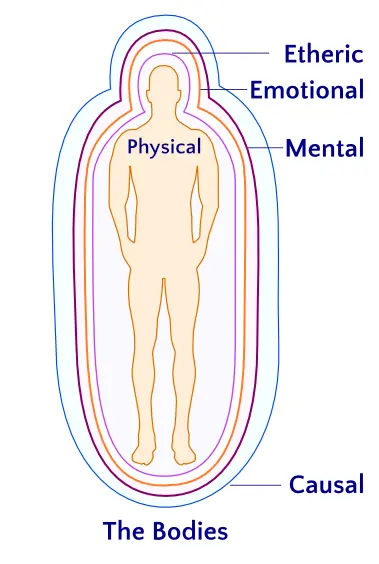
All the envelopes except the organism are aggregate envelopes. The aggregate envelopes consist of atoms and molecules held together magnetically. The four “invisible” aggregate envelopes (etheric, emotional, mental and causal) are oval in shape and extend between 30 and 45 cm beyond the organism, making the so-called aura. The aura makes up man’s total life from his birth to the end of his incarnation. The aura radiates energy and makes up the monad’s possibility of consciousness and the domain of the monad’s apprehension; it is the receiver of all impressions, subjective or objective, from the four worlds. The colours of the aura indicate the individual’s level of development, especially the colours of the mental and emotional envelopes.27
The etheric envelope consists of evolutionary matter; and all the higher envelopes, of involutionary matter. The matter of an aggregate envelope is constantly circulating through the entire envelope like the blood in the organism, and is constantly renewed like the air in the lungs. Approximately 99 per cent of the matter of these envelopes is attracted to the organism, so that the aggregate envelopes form complete replicas of the organism.
The lower four of these envelopes are renewed at each new incarnation and are dissolved in order at the end of the incarnation. The causal envelope is man’s one permanent envelope. It was acquired when the monad passed from the animal kingdom to the human kingdom. This causal envelope is the “true” man and incarnates together with the human monad which it always encloses.28
Theosophists taught erroneously that man has seven envelopes or “seven principles”. H. P. Blavatsky based this description on her manifest ideal, the 45-selves who were her teachers and had seven envelopes29. But they were not members of human kingdom (the fourth kingdom) anymore, but already members of the fifth or superhuman kingdom. Later C. W. Leadbeater was able to correct this statement and describe the five envelopes of man.
The purpose of man’s envelopes
The consciousness development of the monads goes on in and through envelopes. It is by acquiring consciousness in its envelopes and in the ever higher molecular kinds of these envelopes that the monad attains ever higher natural kingdoms.30
Each of these envelopes has its special purpose. Without a physical etheric envelope the individual would lack sense perceptions, without an emotional envelope the individual would lack feelings, and without a mental envelope the individual would lack the ability to think. It is the presence of these envelopes in the human organism that enables the various pertaining organs to fulfil their tasks as long as they can function. It should be emphasized here that every cell of the organism, every molecule in the cell, contains physical atoms which themselves contain atoms of all the 48 higher kinds.31
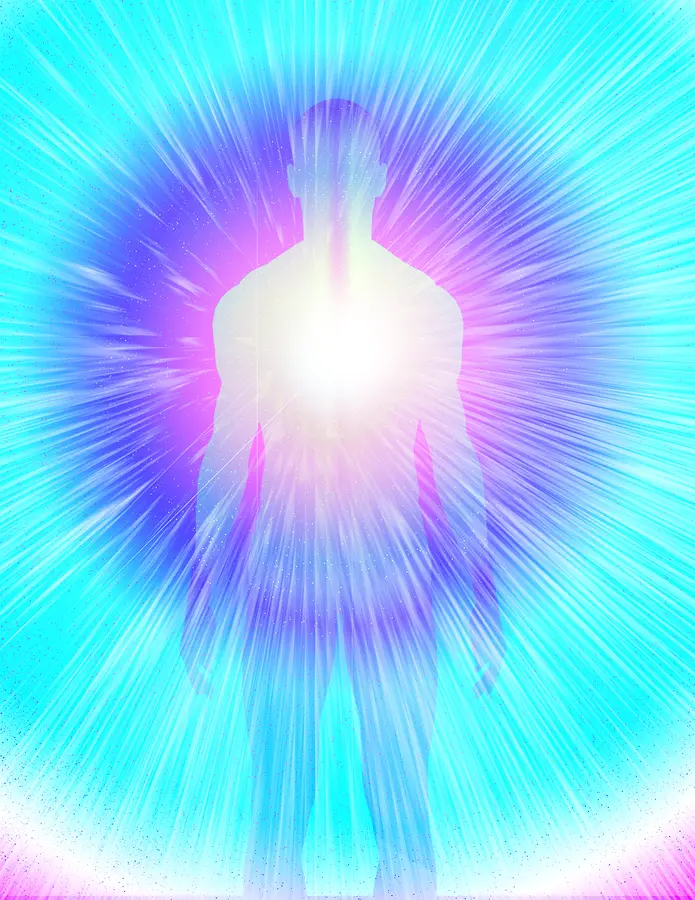
Just as the organism all higher envelopes have their special organs (made of atoms), which are the seats of the different kinds of functions of consciousness and of motion. These atomic organs in the etheric, emotional, mental, and causal envelopes are in contact with each other.32
The envelopes are easily activated by the faintest vibration. The envelopes are perfect robots that automatically reproduce all kinds of vibrations (consciousness expressions) they receive within their molecular domains. Therefore, the percentages of the different molecular kinds in the envelopes are very important. At his lowest two stages of development, for instance, man’s emotional envelope predominantly consists of the lower three or four molecular kinds (48:4-7). The lower the level of development within the stage, the greater the percentage of lower molecular kinds, and so the monad receives chiefly vibrations from the corresponding lower regions of the emotional world.33
The envelopes are never at rest, for they are pervaded in every second by countless vibrations in their worlds, vibrations produced by molecules with energy and consciousness. It is this influence from without that “telepathically” supplies the envelopes with all manner of illusions and fictions, which (if they are apprehended by the self) the individual takes to be his own feelings and thoughts.34
So, it can be said that man is not one being, but several beings at the same time. An average man in incarnation is at least three beings simultaneously, since he has consciousness in his physical etheric, emotional, and mental envelopes. It depends on the level of development and his acquired capabilities how well is he able to control those beings and make them function efficiently, purposefully and according to the Law. It takes thousands of incarnations to integrate those beings into a well-functioning and beneficial whole.
The envelopes are not the self
Generally, man is controlled by the consciousness content of his envelopes with their tendencies (our qualities self-acquired during thousands of incarnations).35
But it is important to understand that the envelopes of incarnation are not the self. The monad, the self, incarnates time and again until it can be sovereign in its envelopes. These envelopes are the monad’s own work, performed during all its incarnations ever since the monad received a causal envelope and in so doing passed from the animal to the human kingdom. The monad is long a slave to the energies of these vibrations, which the envelopes absorb from the vibrations of their worlds in accord with the affinity there is between the molecular kinds of the worlds and the corresponding molecular kinds of the envelopes.36
The worlds of the first self (that is the physical world 49, emotional world 48 and mental-causal world 47) have been made in order that:
- the monad learns to distinguish between the matter aspect and the consciousness aspect,
- the monad becomes conscious of itself and no longer identifies itself with its envelopes (the matter aspect): “I am not my envelopes.”37
All human (physical, emotional, and mental) abilities must be acquired in physical incarnation. Emotionality is ennobled through admiration, affection, and sympathy. Mentality is developed through reflection, the ever more exact apprehension of conceptual contents, increasingly widened perspectives on the relations of existence, through facts of reality being put into their correct contexts in systems of thought that embrace more and more.38
Shortly on man’s four “invisible” aggregate envelopes
Etheric envelope
The matter of the etheric envelope is made up of the four physical etheric kinds (49:1-4): atomic, subatomic, superetheric, and etheric physical matter. The etheric envelope is the physical body proper, because it is the more important of the two physical envelopes. Without the etheric envelope the organism could neither be formed nor have any life. The etheric envelope is the vehicle and conveyor of the various functional energies, which the ancients gave the common name of vital force. Functional deficiencies of the etheric envelope react upon the organism.39

The etheric envelope conveys vibrations between the organism and emotional envelope. It depends on the composition of the etheric matter of the etheric envelope and on the functional capacity of the nervous system to what extent or in which manner these vibrations can be apprehended and reproduced by physical man. The etheric envelope has centres (Sanskrit: chakras) of different kinds of etheric molecular matter. These centres correspond to nerve centres or organs in the organism. Their positions in relation to the organism are defined by the following names:
1 crown centre
2 eyebrow centre
3 throat centre
4 heart centre
5 navel centre
6 sacral centre
7 basal centre
The etheric envelope is faintly luminous in its entirety and violet-blue-grey in colour.40
Emotional envelope
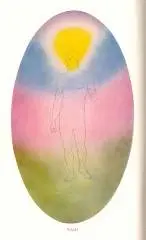
The emotional envelope is composed of all the seven emotional kinds of matter (48:1-7). The proportion of the different states of aggregation varies considerably in different individuals, depending on their level of development. In a civilized and average man, the lower four molecular kinds (48:4-7) make up about 95 percent. In a perfect emotional self, about 99 percent belong to the highest two kinds of matter (48:1,2). When the emotional envelope consists of the highest three kinds (48:1-3) about 50 percent, then man can begin being called Man. Until then, the name subman would be more proper.
The emotional envelope conveys vibrations between the etheric and the mental envelopes. At the present stage of mankind’s development, the emotional and mental envelopes of most people are so interwoven that, during incarnation, they make up one single envelope, as it were. Vibrations in the one envelope are automatically repeated in the other.
The emotional envelope has also seven centres with the corresponding functions and closely connected with the etheric centres and have the same names. These centres, or organs, for consciousness and instruments for the will in different molecular kinds are as though replicas in emotional matter of the centres of the etheric envelope.41
Mental envelope
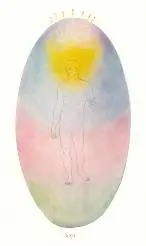
The mental envelope consists of the lower four kinds of mental molecular matter (47:4-7). The material composition of the mental envelope is determined by the monad’s activity in the triad mental molecule, by its faculty of vibration in the different molecular kinds. The percentage of higher mental matter increases according as man develops intellectually. In the recently causalized man, 85 percent of his mental envelope consist of the lowest mental matter (47:7).
The mental envelope conveys the vibrations and the exchange of energies between the emotional and causal envelopes. When man thinks, mental matter is ejected from his mental envelope into the mental world surrounding this envelope. This molecular mass immediately assumes a concrete, plastic form. The clearer and the more distinct the thought, the more finely chiselled is the thought-form. Most thought-forms – mental elementals – are diffuse clouds, muddy in colour, of the lowest molecular kind. Independent thinkers make forms infinitely varied in shape and colour.
The centres of the mental envelope correspond to those of the emotional envelope.42
Causal envelope
The causal envelope, man’s one permanent envelope, is an envelope of involutionary causal matter (47:1-3).
This causal envelope, this causal being, represents the human consciousness proper. Its lifetime lasts from causalization to essentialization. It is the bridge between the first triad and the second triad.
The causal envelope of the recently causalized man is even from the beginning somewhat larger than the other envelopes. Its material density is minimal, however, so that the causal envelope, enclosing the lower envelopes, more resembles a thin film than anything else. Towards the end of its existence, when once filled up, organized, and penetrating the lower envelopes, it can grow tremendously in size.
During incarnation the first self (man) has two causal envelopes. This condition lasts until the monad becomes a causal self. At the time of involvation (incarnation) the causal envelope is divided into two. The greater part, serving as a collector of matter supplied, remains in the causal world. The smaller part (the triad envelope), containing the lowest triad, encloses the lower envelopes. When the involvation (incarnation) of the first self is concluded and the personality is dissolved, the two separate parts amalgamate to form one single causal envelope.
Among the functions of the lower envelopes is to contribute to the development of the causal envelope, by supplying it with causal matter as well as by influencing this matter into activity. This is done by involvation of causal matter into the lower envelopes and by vibrations from these envelopes. The causal matter involved from the causal envelope can, by attractive vibrations at the stage of culture, attract other causal matter, which it can bring with it later at the amalgamation of the two causal envelopes. In order to reach the causal envelope without fail and be able to activate its matter, the vibrations must belong to the superetheric molecular kind: physical 49:3, emotional 48:3, mental 47:5. As long as these lower envelopes are so undeveloped that such vibrations do not occur, there is no such influence. As for consciousness, this implies that superconscious causal consciousness remains almost inaccessible to lower consciousness.43
Lars Adelskogh The Etheric Envelope part One, 1.1.9 and 1.1.11 ↩︎
History of Therapeutic Touch at Pumpkin Hollow Retreat Center, at TherapeuticTouch.org ↩︎
Dr Shafica Karagulla Breakthrough to Creativity (1967), p 228-229 ↩︎
Dr Shafica Karagulla Breakthrough to Creativity (1967), pp 124-125, 142, 182 ↩︎
Dora van Gelder The Real World of Fairies (1977), p 4 ↩︎
C. W. Leadbeater Clairvoyance"(1899), p 6 ↩︎
C. W. Leadbeater Man Visible and Invisible (1902), p 15-16 ↩︎
Ibid, p 94 ↩︎
Ibid, p 54 ↩︎
Ibid, p 12 ↩︎
Oliver Fox Astral Projection: A Record of Out-of-the-Body Experiences (1962), p 151 ↩︎
Sylvan Muldoon, Hereward Carrington The Phenomena of Astral Projection" (1951), pp 30-31 ↩︎
Dr Mary Neal on TEDx JacksonHole speech on Nov 9, 2018 ↩︎
Zingrone NL, Alvarado CS. Pleasurable Western adult near-death experiences: features, circumstances, and incidence. In: Holden JM, Greyson B, James D, editors. The Handbook of Near-Death Experiences: Thirty Years of Investigation. Santa Barbara, CA: Praeger/ABC-CLIO; 2009. pp. 17–40. ↩︎
Dr Raymond Moody Life After Life (1975) ↩︎
Mary Neal webpage; Page at the South Bay (San Francisco Bay Area) IANDS ↩︎
Tom Long’s interview “In Deep Shift with Jonas Elrod”, Feb 3, 2015 ↩︎
Yuliya Vorobeva (in Russian) ↩︎
More about her case (in Russian) ↩︎
Henry T. Laurency The Way of Man, 3.2.3 ↩︎
Henry T. Laurency The Knowledge of Reality, 1.14.1-5, The Philosopher’s Stone, 2.19.2 ↩︎
Henry T. Laurency The Knowledge of Reality, 3.3.24 ↩︎
Ibid, 1.13.1 ↩︎
Ibid, 1.14.5 ↩︎
Ibid, 1.14.6 ↩︎
Henry T. Laurency The Way of Man, 3.3.2 ↩︎
Ibid, 3.2.5 ↩︎
Ibid, 3.11.7 ↩︎
Ibid, 3.5.1 ↩︎
Ibid, 3.4.1 ↩︎
Ibid, 3.1.10 ↩︎
Henry T. Laurency The Philosopher’s Stone, 2.19.3 ↩︎
Ibid, 2.20 ↩︎
Ibid, 2.21 ↩︎
Ibid, 2.22 ↩︎
Ibid, 2.23 ↩︎
